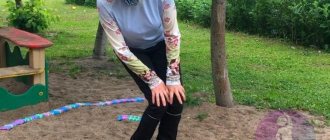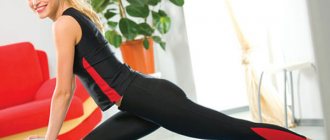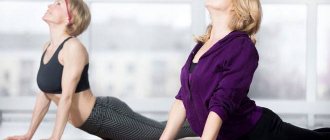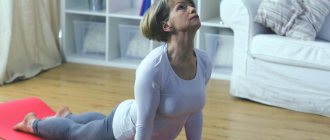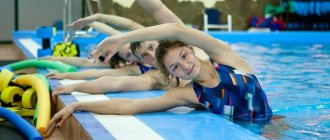To be or not to be morning exercises
Have you ever noticed how many people are in a bad mood in the morning? Doctors believe that one of the reasons for this condition is hypokinesia. In other words, in the absence of physical activity. Nothing surprising. Trained muscles send a sufficient number of impulses to the brain, thanks to which it actively tunes into a working mood.
People who refuse morning exercises often suffer from nervous excitability and experience chronic fatigue. They complain of lack of energy and vigor in the morning. And only by noon do such people notice an increase in activity.
Why do you need charging?
The human body is not able to fully wake up when the alarm clock rings. And even at the moment when you have already risen from bed, all internal organs and systems still continue to “rest”.
During sleep, blood circulation slows down, metabolism slows down, and mental activity decreases. That is why, when waking up, a person feels slightly lethargic. He has decreased performance, both physical and mental. In the morning, the speed of reactions is significantly worse.
This condition can last (depending on individual characteristics) from 1 to 3 hours. To fully wake up and shake off such “inhibition”, it is necessary to develop joints and muscles. In other words, you just need to exercise.
What is the benefit of charging?
Since childhood, our parents have told us about the need to do exercises. Only a few meekly listened to such recommendations. And most people, before starting to do morning exercises, strive to understand what is so valuable that it brings.
Physical activity in the morning provides the following.
Invigorates
The human body wakes up much faster and more actively if even a small exercise has been done. After physical exercise, blood circulation is activated. All organs and tissues begin to be actively saturated with oxygen. You feel a surge of energy and your well-being improves. The brain, having received its portion of oxygen, is actively involved in the work process.
Improves physical fitness
Regular exercise leads to strengthening muscle tissue. Physical education has a positive effect on the condition of the spine and joints. Even simple and short-term gymnastics serves as an excellent prevention of the development of many diseases of the musculoskeletal system.
Morning exercise stimulates metabolism. Thanks to this, a person gradually acquires beautiful forms. Some muscles are pumped up, slimness appears, and the stomach is tightened.
Improves mood
Why exercise when you can cheer yourself up with a cup of coffee? Alas. This is wrong. A flavored drink will not provide the energy and positivity that morning exercises will give.
Exercise involves a set of simple exercises that are aimed at warming up the muscles and working out the joints. Morning physical exercise does not contain any excessive stress. And therefore it does not cause a feeling of fatigue or pain.
During exercise, the body increases the production of endorphins. These joy hormones can significantly improve your mood and charge you with positivity for the whole day.
Strengthens willpower
Having decided to do exercises, you need to force yourself to get up 10-15 minutes earlier. At first, with the right attitude and appropriate motivation, you will easily overcome this barrier.
But over time, around 20-21 days, serious difficulties may begin. Positive results at this time are still little noticeable. Therefore, obsessive thoughts begin to appear: “Why do I need this exercise, it still doesn’t give anything. It’s better to sleep an extra 10-15 minutes.” It is precisely at this moment that it is important not to succumb to such thoughts and overcome yourself. This “exercise” will greatly improve your willpower.
Hal Elrod, in his world-famous book Morning Magic, states that once you get past the crisis on day 21 and reach day 30, you will have fully formed a habit. Your body will wake up with ease. And you will begin to have a positive attitude towards morning exercises.
Improves health
Morning exercises have a complex effect on the body. It activates blood circulation and speeds up metabolism. Thanks to improved blood flow, all internal organs receive sufficient nutrition and begin to function much more actively.
The benefits of morning exercises include the following effects:
- strengthening the heart muscle;
- improving the functioning of the respiratory system;
- increasing muscle elasticity;
- normalization of the condition of blood vessels, increasing their patency;
- posture alignment;
- increased concentration;
- increased joint mobility;
- stimulation of brain function;
- increasing endurance;
- normalization of the vestibular apparatus.
Exercise is especially useful for those people who are forced to lead a sedentary lifestyle. For them, physical education is a necessity.
The importance of morning exercises. physical education article on the topic
The meaning of morning exercises, its tasks.
Daily morning exercises at a certain time in a hygienic environment, properly selected sets of physical exercises, disinhibit the nervous system of children after sleep, activate the activity of all internal organs and systems, increase physiological metabolic processes, increase the excitability of the cerebral cortex, as well as the reactivity of the entire central nervous system . The flow of impulses going to the brain from all receptors - visual, auditory, musculoskeletal, skin - increases the vital activity of the body as a whole.
Regular exercise in the fresh air helps to harden the child’s body and develop resistance to various adverse environmental influences. The introduction of corrective exercises into complexes contributes to the formation of the arch of the foot and correct posture. Thus, morning exercises are a multifaceted physical education and health process that systematically improves the health of the child’s body.
In addition to its health benefits, morning exercises also have great educational value. Its systematic implementation instills in children the habit of doing physical exercise every day, teaches them to start their work day in an organized manner, act in a coordinated manner in a team, be purposeful, attentive, self-controlled, and also evokes positive emotions and a joyful feeling.
In addition, daily performance of certain sets of physical exercises helps improve motor abilities in children, develops physical qualities (strength, agility, flexibility), improves the functioning of coordination mechanisms, and contributes to the acquisition of knowledge in the field of physical education.
Morning exercises are a valuable means of improving the health and education of children. Those who systematically engage in morning exercises lose their drowsiness, feel cheerful, experience an emotional upsurge, and improve their performance. The need to get out of bed immediately after waking up and start doing exercises requires a certain volitional effort, develops perseverance, and disciplines children.
Thus, morning exercises face very special tasks, namely: to “wake up” the child’s body, set it up in an effective way, diversify but moderately influence the muscular system, activate the activity of the cardiac, respiratory and other functions of the body, stimulate the work of internal organs and sensory organs, promote the formation of correct posture, good gait, and prevent the occurrence of flat feet.
Morning exercises are also valuable because children develop the habit and need to do physical exercise every day in the morning. This useful habit remains with a person for life.
Morning exercises allow you to start the day in an organized manner in kindergarten and promote strict adherence to the daily routine.
Morning hygienic exercises, or exercises as they are called, should be performed immediately after sleep. But this can only be done in kindergartens with night groups. In preschool institutions with daytime children, morning exercises according to the daily routine are carried out before breakfast after the children have already been quite active, varied activities. In these conditions, gymnastics also pursues the goals of organizing a children's team, switching children's attention from free, individual games and activities to joint activities.
Due to the simultaneous joint moderate motor activity, more excited children, who have already run and jumped, calm down, while less active children become more active. All this creates an even, cheerful mood in all children, preparing them for subsequent classes. Thus, the educational value of morning exercises, when carried out not immediately after sleep, but after some time, expands. It becomes an integral organizing moment in the daily routine, teaching children to a certain discipline and order.
At the same time, the enormous health value of morning exercises remains. Daily physical exercise has a beneficial effect on the physical development and functional state of the child’s body. The content of gymnastics consists of exercises for various muscle groups (shoulder girdle, torso, legs, etc.). Their systematic repetition strengthens the child’s motor system. Exercises are widely included to prevent poor posture and prevent flat feet. Running and jumping further enhance breathing and circulation, cardiac activity and other physiological functions. All this contributes to the normal functioning of the body and increases its performance.
Structure and content of morning exercises
Any physical activity, including morning exercises, begins with a warm-up and ends with recovery exercises. Since morning exercises are not long (5 - 12 minutes) and the physical activity involved is not great, this requirement is observed as a general principle.
In daytime kindergarten groups, morning exercises as an obligatory part of the daily routine are carried out every day before breakfast.
In the summer, morning exercises are carried out outdoors on the playground, and in rainy weather - on the terrace. In winter, a gym or group room is used for morning exercises, the air temperature of which should not exceed 16 degrees C. Before classes, the room is well ventilated and wet cleaned.
Morning exercises are conventionally divided into three parts: introductory, main and final. Each part has its own tasks and content. In the first, introductory part, they organize the attention of children, teach them coordinated actions, develop correct posture and prepare the body for performing more complex exercises. For this purpose, they include: formations (in a column, in a line); drill exercises (turns and half-turns to the left, right, around); rebuilding from one column into two, from two columns into four, into a circle, several circles, closing and opening with side steps; short walking, alternating with exercises that help strengthen the musculoskeletal system and the formation of posture (walking on toes, with different positions of the arms, walking with high knees, on the heels, in a cross step); running one after another and scattered or in combination with jumping. The duration of the introductory part lasts on average from 1 to 2 minutes.
In the second, main part, the tasks are set to strengthen the main muscle groups and form correct posture. To solve this problem, perform general developmental exercises in a certain sequence. First, exercises to strengthen the shoulder girdle and arms, which promote expansion of the chest, good straightening of the spine, and development of the respiratory muscles. Then exercises for the trunk muscles. This is followed by exercises to develop the leg muscles and strengthen the arch of the foot. After heavy-load exercises, you should repeat the first exercise or a similar one. The number of repetitions of each exercise depends on the age of the children and their physical fitness.
After completing all general developmental exercises, young children perform jumping or running, which turns into a final walk. Older children perform jumping combined with running, then a final walk with various tasks. The final part of the gymnastics involves walking or sedentary play to restore pulse and breathing.
Selection of exercises, compilation of complexes
The content of morning exercises, as a rule, includes exercises previously learned with children in class, or simple exercises that do not require lengthy learning. During morning exercises, children practice movements. But in order for the exercises to have the desired effect on the child, it is important to achieve clarity, precision of the movements performed, and their sufficient intensity.
The combination of physical exercises, selected in a certain order, makes up the so-called complex. The same complex is repeated throughout the week. If individual exercises of the complex do not lead to the desired results, are too simple, uninteresting or boring for children, they can, at the discretion of the teacher, be replaced with others of the same type or become more complicated by introducing new starting points. Changing the tempo and increasing the number of repetitions of exercises within the complex is also acceptable. The implementation of complexes must be alternated with and without benefits. Children of the first and second junior groups are given exercises with flags, rattles, and cubes. In the middle group - with flags, cubes, ribbons, small hoops, sticks, and a circular rope. Older children should be able to do exercises with different aids: with hoops, gymnastic sticks, balls of different sizes, jump ropes, circular rope, ribbons.
Performing exercises with aids increases children's interest in activities, improves the quality of their performance, teaches them to master objects, and promotes the formation of correct posture.
Including exercises to shape children's posture and strengthen the feet is mandatory. Typically, a set of general developmental exercises for morning exercises is taken from physical education classes; the exercises are selected from those recommended by the program and methodological manuals. The duration, nature, content of morning exercises, and dosage of exercises are different for children of different age groups.
Thus, when selecting general developmental exercises, it is necessary to be guided by the following requirements: exercises must be for all muscle groups, from different starting positions, of different intensity, tempo; with various aids, rhythmic and musical accompaniment, in various formations and always interesting for children.
Various forms of morning exercises are used:
– traditional form using general developmental exercises;
- playing out some plot: “On a walk”, “We went to the meadow”, “Sparrows”, etc.;
– gaming nature (from 3-4 outdoor games);
– using elements of rhythmic gymnastics, dance movements, round dances;
– recreational running (carried out on a site for 3-5 minutes with a gradual increase in distance, intensity, time);
– using an obstacle course (you can create different obstacle courses using a variety of modules);
– using the simplest exercise equipment (children’s expander, gymnastic roller, etc.) and complex exercise equipment (“Bicycle”, “Rowing”, “Treadmill”, “Trampoline”, etc.) [4]
Conditions for morning exercises.
Morning exercises can be carried out outdoors (in the kindergarten area, on the sports ground) or in a well-ventilated room (physical education, music halls, group rooms). It is necessary to comply with hygienic requirements for clothing, shoes, venue, and equipment. For rhythmic accompaniment, a tambourine, counting, clapping, sound recording, and musical accompaniment (piano, button accordion, accordion) are used.
Since morning exercises in kindergarten are considered as an important element of the motor regime, a means for raising the emotional tone of children, its organizational significance is also great. And yet there should be no forced gymnastics. If one of the children does not want to study today, there is no need to force him, but the reason for such behavior should be understood. Here are some tips for doing morning exercises with children:
* No overorganization, strict rules or discipline requirements! It is necessary to ensure complete relaxation in behavior, an elevated emotional state and real joy of movement.
*Remember that gymnastics is not only and not so much a physical education event, but a specially provided regime moment, where a whole range of influences on the diverse development of children is concentrated (movement, music, rhythms, aesthetics of the environment, aids, communication, play).
*Use different forms of gymnastics.
Morning exercises: basic rules and recommended exercises
There is another common misconception. Some people are sure that it is not necessary to do exercises in the morning. You can practice physical activity in the afternoon and even in the evening. If we are talking about morning exercises, then all experts agree on one thing: it should be done in the morning, after waking up. After all, the main goal of such gymnastics is to charge a person with vivacity and energy for the whole day.
5 important recommendations
To maximize the benefits of morning exercises, you must follow the following rules.
Duration of gymnastics
For those who are just starting to introduce morning exercises into their lives, it is recommended to plan 10-minute exercise. Over time, you can increase the time to 15 minutes. When the body fully adapts to the stress (after approximately 3-6 months), begin to increase the charging time to half an hour.
Preparing to charge
You should not start gymnastics immediately after getting out of bed. The body still continues to sleep. Such loads will cause discomfort. Initially, you need to cheer up a little. To do this, it is recommended to wash your face and brush your teeth.
Be sure to drink a glass of water. The fluid entering the body will thin the blood. Thanks to this, it will be possible to normalize the load on the heart and blood vessels. But you shouldn’t have a snack before exercise. Perform all exercises on an empty stomach.
It is recommended to have breakfast 20 minutes after finishing your morning exercises.
Add emotions
Exercise should not only invigorate, but also improve your mood. Therefore, turn on your favorite music, saturate the air with aromatic oils (just don’t overdo it) and do gymnastics. After physical education, be sure to praise yourself, celebrate all your achievements and don’t forget about encouragement.
To ensure that charging brings significant benefits to the body, first ventilate the room. This can be done while you wash your face. The influx of fresh air will saturate the body with more oxygen.
Regularity of classes
If you do exercises from time to time, then you should not hope for positive results. Only daily exercise will bring benefits. Moreover, the first results will become noticeable after 5-6 weeks of regular training.
At this time, people usually note a decrease in stress levels, a positive attitude, and a decrease in excitability and irritability. Practitioners of morning exercises claim that by the 5-6th week, performance increases, discipline and perseverance increase. People become stronger and practically do not catch colds.
Subtleties of choice
It is necessary to start with low-intensity exercises and gradually increase the load. The difference from a full workout is that after exercise you should never feel tired. If this happens, then shorten your morning warm-up or make it slower. At the same time, morning exercises are not relaxation or stretching. During class, you should feel that your heart has begun to beat faster and your breathing has become faster. After morning exercises, you should definitely feel a feeling of lightness and cheerfulness. If, after charging, you are going to go to the gym or, for example, ride a bike, the charging should be longer and end at a higher heart rate than usual.
Another important point is breathing. Try to breathe as deeply as possible, not only with your full chest, but also with your stomach. This will open up the lungs that have collapsed overnight and increase the amount of oxygen entering the blood. In turn, increasing the amount of oxygen and improving blood circulation will speed up metabolism and increase the amount of fat burned during movement.
